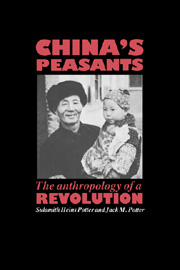Book contents
- Frontmatter
- Contents
- List of illustrations
- List of tables
- Preface
- Notes on the text
- Map 1 China
- 1 The old “feudal” order: Zengbu before Liberation
- 2 Establishing the new order
- 3 The ordeal of collectivization
- 4 The Cultural Revolution
- 5 Maoist society: the production team
- 6 Maoist society: the brigade
- 7 Maoist society: the commune
- 8 Impatient aspirations: transition to the post-Mao period
- 9 The cultural construction of emotion in rural Chinese social life
- 10 Marriage, household, and family form
- 11 Chinese birth planning: a cultural account
- 12 Lineage and collective: structure and praxis
- 13 Party organization
- 14 The party ethic: a devotion born of distress and enthusiasm
- 15 A caste-like system of social stratification: the position of peasants in modern China's social order
- 16 The Chinese peasants and the world capitalist system
- 17 The crystallization of post-Mao society: Zengbu in 1985
- References
- Index
5 - Maoist society: the production team
Published online by Cambridge University Press: 02 December 2009
- Frontmatter
- Contents
- List of illustrations
- List of tables
- Preface
- Notes on the text
- Map 1 China
- 1 The old “feudal” order: Zengbu before Liberation
- 2 Establishing the new order
- 3 The ordeal of collectivization
- 4 The Cultural Revolution
- 5 Maoist society: the production team
- 6 Maoist society: the brigade
- 7 Maoist society: the commune
- 8 Impatient aspirations: transition to the post-Mao period
- 9 The cultural construction of emotion in rural Chinese social life
- 10 Marriage, household, and family form
- 11 Chinese birth planning: a cultural account
- 12 Lineage and collective: structure and praxis
- 13 Party organization
- 14 The party ethic: a devotion born of distress and enthusiasm
- 15 A caste-like system of social stratification: the position of peasants in modern China's social order
- 16 The Chinese peasants and the world capitalist system
- 17 The crystallization of post-Mao society: Zengbu in 1985
- References
- Index
Summary
The production team (shengchan dui) was the most significant social structure in Zengbu from the end of the radical Great Leap Forward experiment, in 1961, until the demise of Maoist society in the early 1980s. It provided the economic, political, and social framework within which Zengbu's peasants organized their lives, and a generation of young people grew up with the understanding that this collective form of society was the locus of their efforts to earn a living.
The production team, as a corporate group, collectively controlled the social organization of production. It had exclusive rights over its share of land, and it owned the instruments and means of production – tractors and other agricultural machines and implements, fishponds, orchards, drying floors, storage buildings, and team headquarters. The team also controlled the labor power of its members. The basic organizational principle of the team was that it should maintain strict economic equality among its members and its constituent households. Labor was rewarded as a proportion of the team's profits. After the team had paid its taxes, delivered its compulsory crop quotas to the state, and set aside funds for production expenses, welfare, and capital investment, it distributed its yearly net profits to its constituent households on the basis of their contribution of labor, as measured in the number of workpoints they had earned over the course of the year. The team was also the usual source of a minimal guaranteed food supply.
- Type
- Chapter
- Information
- China's PeasantsThe Anthropology of a Revolution, pp. 94 - 128Publisher: Cambridge University PressPrint publication year: 1990



